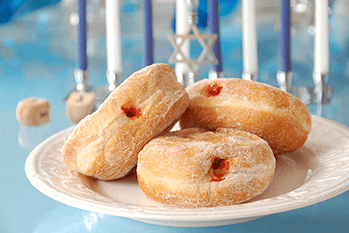Christmas isn’t the only holiday being celebrated this month. Besides Christmas Eve, December 24th also marks the beginning of Hanukkah, the Jewish holiday commemorating the rededication of the Holy Temple in Jerusalem. Also known as the “Festival of Lights,” Hanukkah is observed for eight straight nights and days, starting on the 25th day of Kislev, a month in the Hebrew calendar. Hanukkah may occur anywhere from late November to late December, according to the Gregorian calendar.
As with Christmas, Hanukkah carries its own rich holiday traditions. As the story goes, a flask with only enough oil to light the menorah in the Holy Temple for one day was able to miraculously last eight nights. Those who celebrate Hanukkah commemorate the Temple miracle by eating foods fried in oil.
One of these delicious treats is called sufganiyah(soof-gah-nee-ah) a deep fried donut, filled with jelly or custard, topped with powdered sugar.
The word sufganiyah can be traced back to the arabic word “sfenj” a smaller type of deep-fried donut. Jews in North Africa have eaten similar fried balls of dough to celebrate Hanukkah for centuries.
But sufganiyah didn’t contain their iconic jelly filling until they reached central Europe. Colonies established in the carribean brought cheap sugar to Europe in the 16th century. Fruit preserves quickly became popular and, as a result, so did fruit filled pastries. The recipe for jelly donuts spread throughout Europe, eventually reaching Jews in Poland. The Polish Jews substituted the un-kosher lard with goose fat and began eating the donuts regularly on Hanukkah.
These groups eventually fled Europe, fearing the harsh anti-semitism of the early 20th century and migrated to Israel. Fortunately, they brought along their delicious jelly filled pastries. From there the Hanukkah tradition of Sufganiyah began to spread around the world.
For more the latest news on delicious treats, don’t forget to keep up our blog. Please follow us on Facebook and Twitter.

